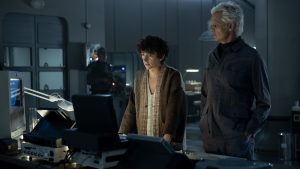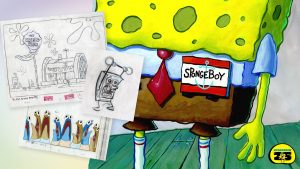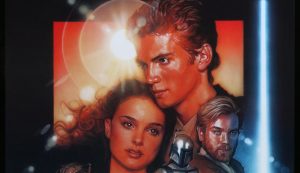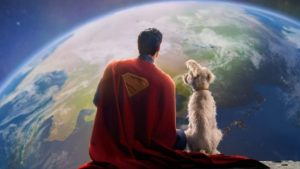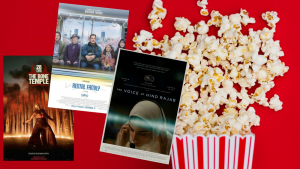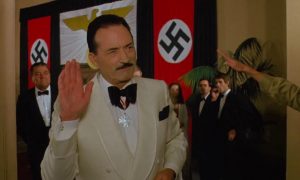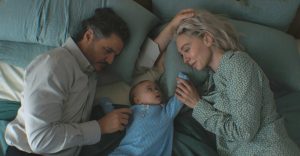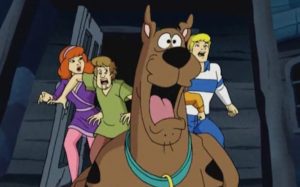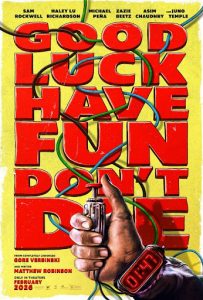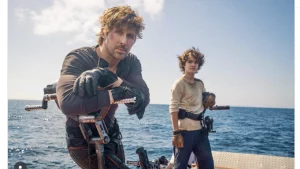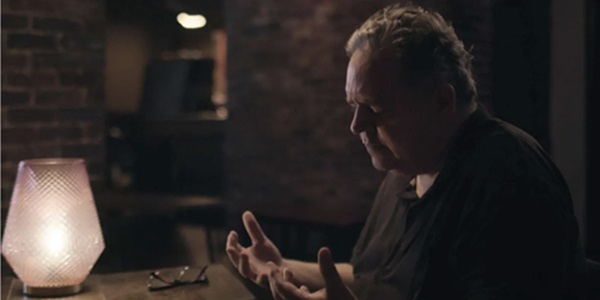
More than eight million people live in the five boroughs of New York City. Yet, anyone who has ever lived here or another city of similar size can confirm that it’s possible to be surrounded by so many people and still be unbearably lonely. Sometimes, you find yourself looking for brief moments of human connection wherever you can: a friendly bartender who asks about your work day, a chatty supermarket clerk who comments on the ingredients you’re buying, a stranger on the subway who says they’re reading the same book you are.
Look Into My Eyes, the new documentary from Emmy Award-winning filmmaker Lana Wilson (After Tiller, Miss Americana), looks at another way many people seek connection: appointments with psychic mediums. Shot by Stephen Maing in a straightforward way that avoids leaning into supernatural tropes, this deeply empathetic and refreshingly non-judgmental film introduces us to a small group of New York City-based psychics who, through their readings, attempt to provide healing moments for their clients while also finding some healing themselves along the way. And whether or not you believe in psychic abilities—even the psychics featured in the film express doubts—the moments of intimate, intense human connection that occur during these readings are undeniable.
Séance on a Wet Afternoon
Look Into My Eyes begins by showing us only the faces of the clients, all of whom are looking for some kind of emotional reassurance: the middle-aged doctor who needs to know if the girl who died from a gunshot wound during one of her first emergency room shifts is at peace, the young man who is having an existential crisis about what the future holds, the son who wants to connect with the father who missed out on so much of his life after dying from a drug overdose. The psychics at first remain offscreen, ambiguous presences, allowing us to imagine who these people are, what they’re like, and whether they fulfill the stereotype of the spooky, bead-draped, crystal ball-wielding psychic that populates the pop culture landscape.
source: A24
When they’re eventually revealed in the reverse shots, we’re introduced to seven people of various ages, races, genders, sexualities, and backgrounds, all of whom are so much more than mere cliche. Yet as different as they all may be, certain characteristics recur that seem to make them particularly adept at this work. Personal experience with trauma and grief is one; Eugene Grygo breaks down in tears discussing how his beloved brother died before his time while Phoebe Hoffman relays memories of a youth spent angry, confused, and addicted to drugs before she discovered her true calling as an animal communicator. (She’s also a huge John Waters fan, and quite possibly the most colorful of all the colorful characters showcased here.) For them and others, discovering their psychic abilities gave them a purpose in life that they may have otherwise been lacking; they found a way to heal their wounds by healing the wounds of others.
Another thing that many of them have in common is a creative background, particularly as performers; Grygo goes to vocal lessons to prepare for an open mic night, Michael Kim rehearses lines for an audition, Ilka Pinheiro compares doing a reading to improv, and Sherrie Lynne channels her past as a stage performer into work as a party psychic for hire (and embraces many of those aforementioned cliches, mostly because she knows it’s expected of her). It makes sense that people with a knack for storytelling and theatricality would be natural fits for work that is so sensitive and occasionally quite dramatic, though it does lead the audience to wonder: is it all just an act? Are these readings just another way for these folks to hone their performance skills for the big break they’re still waiting for? Are the vulnerable and grieving being taken advantage of solely to boost these psychics’ fragile egos? Look Into My Eyes doesn’t provide any easy answers—that’s part of what makes it so fascinating—but it does give the audience a healthy amount of food for thought.
Blithe Spirits
Throughout Look Into My Eyes, we witness powerful readings as well as occasional misfires. In one of the film’s most impactful scenes, a young Black man consults Pinheiro in an attempt to contact an ancestor who was enslaved; he recently discovered that the ancestor was valued at $250, cannot get that number out of his mind, and wants guidance on how to do so. In relaying the message from the other side, Pinheiro is almost as deeply affected as the client, wiping away tears and encouraging him to cast off his ancestor’s shackles; it’s a good peiece of advice no matter where it’s coming from. In another poignant moment, an acting school classmate of Kim’s is surprised to see that the psychic she’s consulting is someone who knows her and the deceased friend she’s trying to contact; the resulting reading is a nice moment of healing for both her and Kim, who is also caught off guard by the coincidence (something that cynics will no doubt seize upon).
source: A24
By contrast, during one painfully awkward scene, Per Erik Borja is so convinced that he’s communing with a young male spirit who used to skateboard that when the client says she doesn’t know anyone who fits that description, he breaks the fourth wall and asks Wilson and her crew if perhaps they do instead. (They don’t, and Borja is forced to start from scratch.) The scene gives one a sense of second-hand embarrassment, yet for me, it also felt more authentic than if every single reading featured in the movie was totally spot on (though it’s worth noting that as someone who frequently consults her horoscope and her tarot deck, I’m already more predisposed to believe). Borja notes at another point in the film that even he isn’t always convinced that what he’s saying is true, and other psychics relay a similar skepticism in their abilities. Whatever the case may be, one thing is certain: these readings are therapeutic to psychics and clients alike.
Conclusion
Towards the end of Look Into My Eyes, the psychics are brought together for what essentially amounts to a group therapy session; when Barja mentions that he’s been grieving a close friend who passed, others in the room claim to feel him there and to have messages to pass on. It’s all very vague and and light on detail—I wouldn’t be surprised if they were making it up to make him feel better in that moment—but it comforts Barja nonetheless. And if that’s the case, does it matter whether it’s real or not? It’s worth watching Look Into My Eyes and trying to make up your mind for yourself.
Look Into My Eyes opens at Film Forum in New York on September 6, 2024.
Does content like this matter to you?
Become a Member and support film journalism. Unlock access to all of Film Inquiry`s great articles. Join a community of like-minded readers who are passionate about cinema – get access to our private members Network, give back to independent filmmakers, and more.
